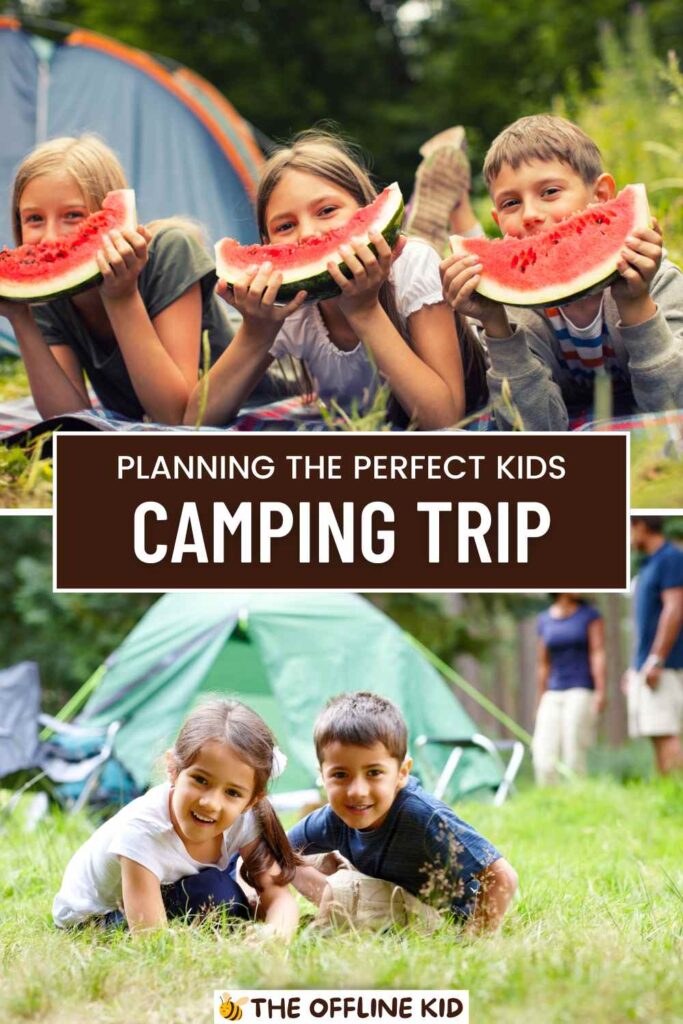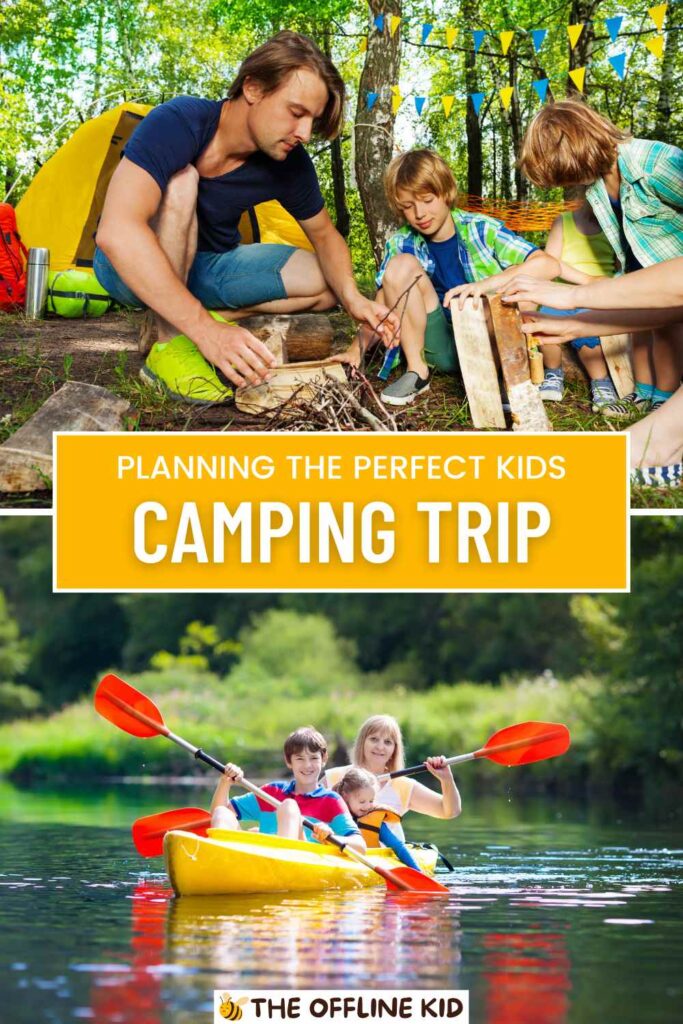Camping with kids is a fantastic way to bond as a family, explore nature, and create unforgettable memories.
This comprehensive guide will help you plan the perfect camping trip, covering everything from choosing the right campsite to packing essentials, meal planning, and fun activities.
Choosing the Right Campsite
Camping with kids starts with selecting the perfect campsite. The right location can make all the difference in ensuring a fun and safe experience for the whole family.
Considerations for Selecting a Family-Friendly Campsite
When choosing a campsite, consider the following factors to ensure it meets the needs of your family:
- Proximity to Home: Opt for a campsite that’s not too far from home, especially if it’s your first camping trip with kids. This can help minimize travel stress and make it easier to return home if necessary.
- Availability of Amenities: Look for campsites that offer essential amenities such as bathrooms, showers, and potable water. Some sites also provide playgrounds, picnic tables, and grills, which can add to the convenience and enjoyment.
- Kid-Friendly Activities: Choose a campsite with plenty of activities for kids, such as nature trails, swimming areas, fishing spots, and playgrounds. These features will keep your children entertained and engaged.
Researching and Booking the Campsite
To find the ideal campsite, follow these steps:
- Popular Camping Destinations for Families: Research destinations known for their family-friendly facilities and activities. National and state parks often have well-maintained campgrounds with a variety of amenities.
- Reading Reviews: Check online reviews and forums to learn from other families’ experiences. Look for insights into the campsite’s cleanliness, safety, and kid-friendliness.
- Making Reservations Early: Popular campsites can book up quickly, especially during peak seasons. Plan and make reservations well in advance to secure your spot.
By taking these considerations into account and doing thorough research, you’ll be well on your way to finding the perfect campsite for your family adventure.
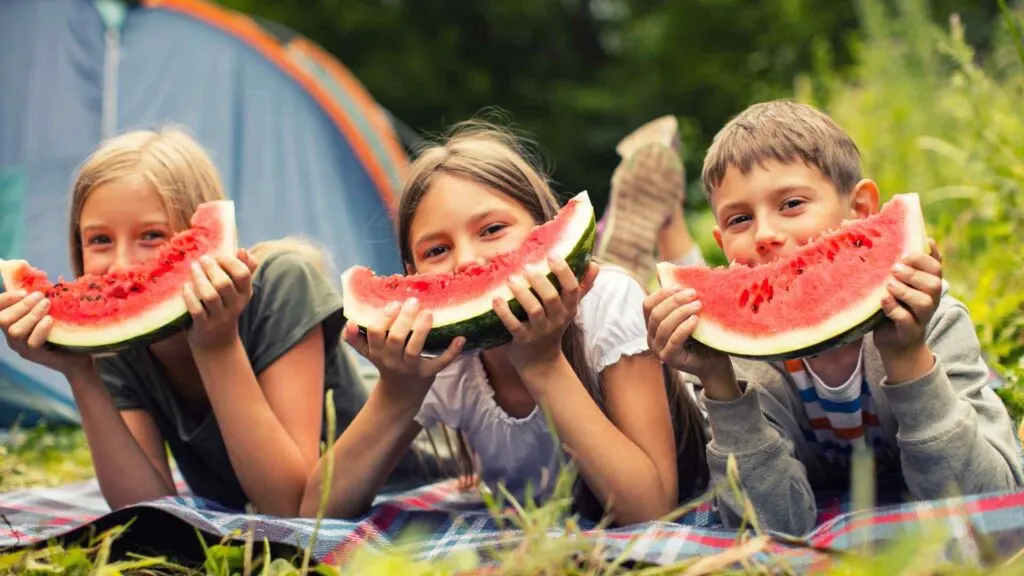
Packing Essentials
Packing for a camping trip with kids requires careful planning to ensure you have everything you need for a comfortable and enjoyable experience. Here’s a comprehensive packing list to get you started.
Creating a Comprehensive Packing List
Camping Gear
- Tents: Ensure you have a spacious, easy-to-set-up tent that accommodates your family comfortably. Consider a tent with separate rooms for privacy.
- Sleeping Bags: Choose sleeping bags appropriate for the season and weather conditions. Bring extra blankets for added warmth.
- Sleeping Mats or Air Mattresses: Provide cushioning and insulation from the ground to ensure a good night’s sleep.
- Camping Chairs and Table: Foldable chairs and a portable table can make meals and activities more comfortable.
Cooking Supplies
- Portable Stove and Fuel: A portable camping stove with sufficient fuel is essential for cooking meals.
- Cookware and Utensils: Pack pots, pans, spatulas, tongs, and other cooking essentials. Don’t forget plates, bowls, cups, and cutlery.
- Cooler and Food Storage: A sturdy cooler for perishables and containers for dry goods will keep your food fresh and organized.
- Cleaning Supplies: Bring dish soap, sponges, and a basin for washing dishes. Trash bags are also necessary for waste disposal.
Clothing and Footwear
- Layered Clothing: Pack clothing that can be layered for different weather conditions. Include T-shirts, long sleeves, hoodies, and jackets.
- Waterproof Gear: Raincoats, waterproof pants, and sturdy shoes or boots will keep everyone dry in wet weather.
- Extra Clothes: Pack extra socks, underwear, and a few spare outfits for the kids, as they are likely to get dirty.
- Swimwear: If your campsite has a swimming area, don’t forget swimsuits and towels.
Special Items for Kids
Comfort and Entertainment
- Favorite Toys and Comfort Items: Bring along a few favorite toys, books, or comfort items to keep kids happy and entertained.
- Kid-Sized Camping Gear: Consider child-sized camping chairs, sleeping bags, and utensils to make them feel included and comfortable.
- First-Aid Kit: A well-stocked first-aid kit with child-specific items like bandages, antiseptic wipes, and medications is crucial.
Health and Safety
- Bug Repellent and Sunscreen: Protect your kids from insect bites and sunburn with appropriate repellent and sunscreen.
- Baby Wipes and Hand Sanitizer: These are handy for quick cleanups and maintaining hygiene at the campsite.
Pro Tips for Packing
- Use Clear Bins and Labels: Organize your gear and supplies in clear bins with labels for easy access and visibility.
- Checklists and Planning: Create detailed checklists to ensure you don’t forget anything. Involve the kids in packing to teach them responsibility and build excitement.
- Pack Extra Essentials: Always pack a little more than you think you’ll need, especially items like snacks, water, and first-aid supplies.
With a well-prepared packing list and thoughtful planning, you’ll have everything you need for a smooth and enjoyable camping trip with your kids.
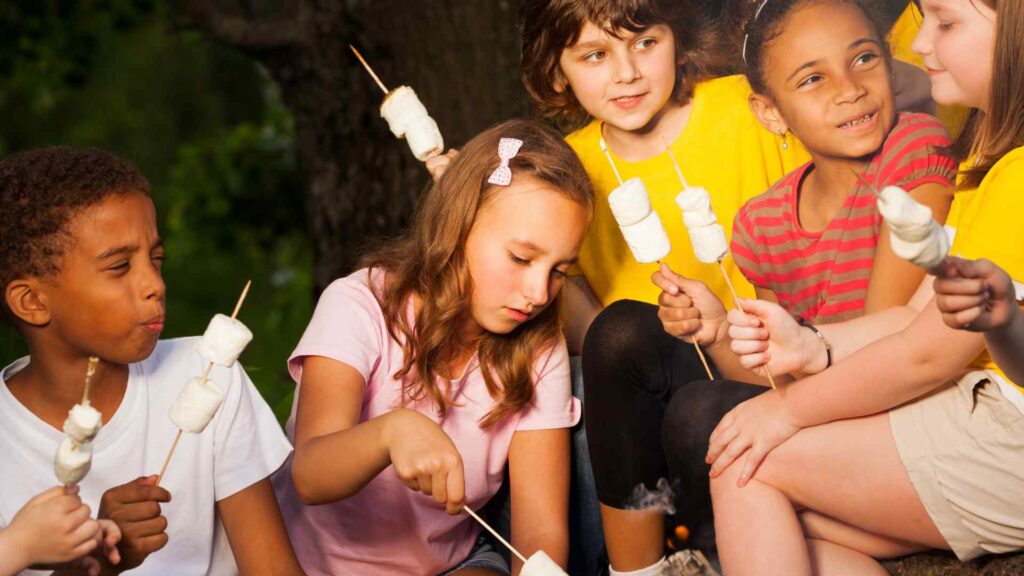
Planning Meals and Snacks
Planning meals and snacks for a camping trip with kids requires simplicity, nutrition, and fun. Here are some ideas and tips to ensure everyone stays well-fed and happy during your adventure.
Easy and Kid-Friendly Meal Ideas
Breakfast Options
- Pancakes: Pre-mix dry ingredients at home and store them in a resealable bag. Add water or milk at the campsite and cook on a portable griddle.
- Cereal and Milk: Simple and quick, perfect for busy mornings. Don’t forget to bring a cooler to keep the milk fresh.
- Fruit and Yogurt: Pack individual servings of yogurt and a variety of fresh fruit for a healthy and refreshing start to the day.
Lunch and Dinner Ideas
- Sandwiches and Wraps: Easy to prepare and customizable. Offer a variety of fillings like deli meats, cheese, veggies, and spreads.
- Hot Dogs and Hamburgers: Classic camping fare that’s quick to cook over a campfire or on a portable grill. Bring all the fixings for added fun.
- Foil Pack Meals: Pre-cut veggies, meat, and seasonings wrapped in foil can be cooked directly over the campfire. This is a fun and interactive meal that kids can help prepare.
Campfire Treats
- S’mores: The ultimate camping treat. Pack graham crackers, marshmallows, and chocolate bars for this classic dessert.
- Roasted Marshmallows: Simple and fun, especially for younger kids. Use extendable roasting sticks for safety.
- Campfire Cones: Fill waffle cones with mini marshmallows, chocolate chips, and fruit. Wrap in foil and heat over the fire for a delicious, melty treat.
Involving Kids in Meal Preparation
Simple Recipes Kids Can Help With
- Trail Mix: Let kids choose their favorite nuts, dried fruits, and chocolate pieces to create their own personalized trail mix.
- Mini Pizzas: Use pita bread or English muffins as the base. Set up a topping station with sauce, cheese, and various toppings for kids to create their own mini pizzas.
- Fruit Kabobs: Provide skewers and a selection of cut fruits for kids to assemble their own colorful and healthy snacks.
Making Mealtime Fun and Educational
- Cooking Lessons: Teach kids basic cooking skills, like how to safely use a knife (with supervision) or measure ingredients.
- Food Science: Explain the science behind cooking, like how heat transforms raw dough into bread or why marshmallows puff up when roasted.
- Themed Meals: Create themed meals, such as “Campfire Night” with all dishes cooked over the fire or “Picnic Lunch” with finger foods and blankets spread out on the grass.
Pro Tips for Meal Planning
- Prep Ahead: Prepare and pre-cook as much as possible at home to save time and effort at the campsite. Chop veggies, marinate meats, and portion out ingredients in advance.
- Portable Kitchen: Invest in a portable camping kitchen or organize your cooking supplies in a way that makes setting up and breaking down meals easy.
- Stay Organized: Use labeled containers and zip-lock bags to keep ingredients organized and prevent spills. A cooler with separate compartments for meals can help keep things tidy.
By planning easy, nutritious, and fun meals, you can keep everyone satisfied and energized throughout your camping trip. Involving kids in the cooking process can also make the experience more enjoyable and memorable for them.
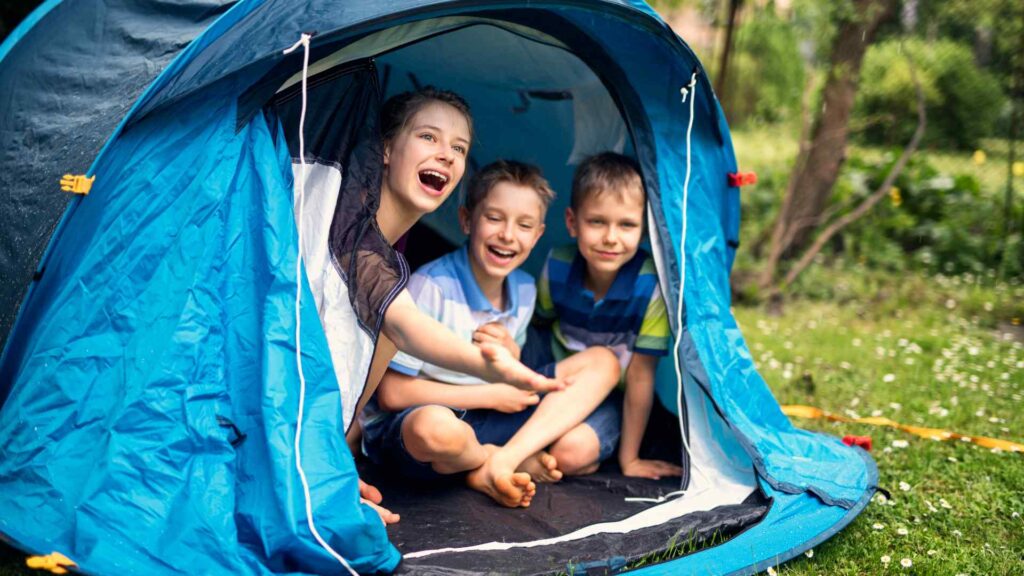
Activities and Entertainment
Keeping kids entertained during a camping trip is key to ensuring they have a fun and memorable experience. Here are some engaging activities and entertainment ideas to keep the little ones busy and happy.
Fun and Engaging Activities at the Campsite
Nature Scavenger Hunts
- Create a list of items for kids to find around the campsite, such as specific leaves, rocks, insects, or animal tracks.
- Provide small bags or containers for collecting items and offer small rewards for completing the hunt.
Storytelling Around the Campfire
- Encourage kids to share their own stories or tell classic campfire tales.
- Bring along a few storybooks or use a storytelling dice game to spark creativity and fun.
Arts and Crafts with Natural Materials
- Collect leaves, sticks, and stones to create nature-inspired crafts.
- Ideas include leaf rubbings, painted rocks, and stick sculptures.
Outdoor Games and Sports
Hiking and Exploring Nature Trails
- Choose kid-friendly trails that are not too long or difficult.
- Teach kids about the plants, animals, and natural features you encounter along the way.
Fishing, Swimming, and Water Activities
- If your campsite is near a lake or river, bring fishing gear and teach kids how to fish.
- Swimming is a great way to cool off and have fun. Always ensure there is adequate supervision and that safety rules are followed.
- Other water activities include skipping stones, floating on inflatable tubes, or having a water balloon fight.
Team Sports
- Bring a frisbee, soccer ball, or other sports equipment for team games.
- Organize a mini-tournament with friendly competitions and prizes.
Quiet Time Activities
Reading and Educational Games
- Pack a selection of books, including nature-themed stories and educational books about wildlife and the environment.
- Bring along educational games and puzzles that can be played at the campsite.
Stargazing and Learning About Constellations
- On clear nights, lay out blankets and look up at the stars.
- Use a stargazing app or a guidebook to identify constellations and learn about astronomy.
Pro Tips for Activities and Entertainment
- Plan Ahead: Research activities that are available at or near your campsite and plan your itinerary accordingly.
- Pack Appropriately: Bring the necessary gear and supplies for the activities you plan to do. This includes sports equipment, craft supplies, and any guides or books.
- Stay Flexible: Be prepared to adjust your plans based on weather conditions and the kids’ energy levels and interests.
- Encourage Exploration: Allow kids to explore their surroundings and discover new interests. This can help them develop a love for nature and the outdoors.
By incorporating a variety of activities and entertainment options, you can ensure that your kids stay engaged and have a blast during your camping trip. Whether it’s an exciting nature scavenger hunt, a relaxing evening of stargazing, or a fun-filled day of water activities, there’s something for everyone to enjoy.
Safety Tips and Precautions
Ensuring the safety of your family is paramount during a camping trip. By taking a few precautions and being prepared, you can create a safe and enjoyable environment for everyone.
Ensuring Campsite Safety
Setting Boundaries and Rules for Kids
- Establish Clear Boundaries: Define the safe areas where kids can play and explore. Mark the boundaries with visible objects like flags or sticks.
- Create Rules: Set simple, easy-to-understand rules about staying within the designated areas, not wandering off alone, and always informing an adult before leaving the campsite.
Fire Safety and Handling Campfires
- Safe Fire Setup: Build campfires in designated fire pits or rings. Keep a bucket of water and a shovel nearby to extinguish the fire quickly if needed.
- Fire Rules: Teach kids about the dangers of fire and establish rules for staying a safe distance away. Only allow responsible adults to manage the fire.
- Extinguishing Fires: Ensure the campfire is completely out before going to bed or leaving the campsite. Douse it with water, stir the ashes, and douse it again.
Wildlife Awareness and Precautions
- Educate About Wildlife: Teach kids about the types of wildlife they might encounter and how to react safely. Explain the importance of not feeding or approaching wild animals.
- Store Food Properly: Use bear-proof containers or hang food from a tree to keep it out of reach of animals. Never leave food unattended.
- Insect Protection: Use insect repellent and wear long sleeves and pants to prevent bites. Check for ticks regularly, especially after hikes.
First Aid and Emergency Preparedness
Basic First Aid Knowledge
- First Aid Kit: Pack a well-stocked first aid kit with bandages, antiseptic wipes, pain relievers, and any necessary medications. Include child-specific items such as children’s pain reliever and antihistamine.
- Basic First Aid Skills: Know how to treat common camping injuries such as cuts, scrapes, burns, and insect bites. Teach older kids basic first aid skills.
Knowing When and How to Seek Help
- Emergency Contacts: Keep a list of emergency contacts, including the nearest hospital, park ranger station, and local emergency services.
- Communication Devices: Bring a fully charged cell phone or a two-way radio for areas with no cell service. Consider carrying a portable charger or extra batteries.
- Emergency Plan: Have a clear plan for what to do in case of an emergency. Make sure everyone knows the location of the nearest help and how to get there.
Pro Tips for Safety
- Regular Check-ins: Regularly check on your kids to ensure they are safe and following the rules.
- Stay Hydrated: Keep everyone hydrated by encouraging regular water breaks, especially during hot weather and physical activities.
- Be Weather Aware: Monitor the weather forecast and be prepared for sudden changes. Have a plan for shelter in case of severe weather.
By taking these safety tips and precautions, you can ensure a safe and enjoyable camping experience for your family. Teaching kids about safety and being prepared for emergencies will help create a secure environment where everyone can relax and have fun.
Camping Etiquette and Leave No Trace Principles
Teaching kids about camping etiquette and Leave No Trace principles helps preserve the natural environment and ensures that everyone can enjoy the great outdoors. Here are some key guidelines to follow.
Teaching Kids About Respecting Nature
Importance of Leaving the Campsite Clean
- Clean Up: Encourage kids to pick up all trash and litter around the campsite. Make a game out of it by seeing who can collect the most items.
- Proper Disposal: Teach kids how to properly dispose of waste by using designated trash and recycling bins. If these are not available, pack out all trash and recyclables.
- Minimal Impact: Explain the importance of leaving natural objects, like rocks and plants, where they are found to minimize human impact on the environment.
Minimizing Impact on Wildlife and Natural Surroundings
- Stay on Trails: Instruct kids to stay on marked trails while hiking to protect vegetation and avoid disturbing wildlife habitats.
- Observe Wildlife from a Distance: Teach kids to watch animals from a safe distance and never to feed or try to touch them. Explain how human food can harm wildlife.
- Campfire Impact: Use established fire rings or portable stoves to minimize the impact of campfires on the environment. Avoid collecting firewood from the surrounding area.
Encouraging Responsible Camping Behavior
Quiet Hours and Respecting Other Campers
- Respect Quiet Hours: Explain the importance of quiet hours, typically in the evening and early morning, to allow everyone to rest and enjoy the peace of nature.
- Respect Privacy: Teach kids to respect the privacy and space of other campers by not walking through occupied campsites and keeping noise levels down.
Proper Waste Disposal and Recycling
- Human Waste: If the campsite lacks facilities, teach kids the proper way to dig a cat hole for human waste and cover it properly. Bring biodegradable toilet paper if necessary.
- Wastewater Disposal: Instruct kids on the importance of disposing of wastewater away from water sources to prevent contamination. Use biodegradable soap for washing dishes and hands.
Pro Tips for Camping Etiquette
- Lead by Example: Model respectful and environmentally-friendly behavior for your kids. They are more likely to follow your lead if they see you practicing good etiquette.
- Educational Activities: Use activities like nature journaling or guided nature walks to teach kids about the environment and the importance of conservation.
- Reward Positive Behavior: Praise and reward kids when they demonstrate good camping etiquette. This reinforcement can encourage them to continue these practices in the future.
By teaching kids about camping etiquette and Leave No Trace principles, you can help them develop a deep respect for nature and a sense of responsibility for preserving it.
These lessons will not only enhance their camping experience but also instill values that they can carry with them throughout their lives.
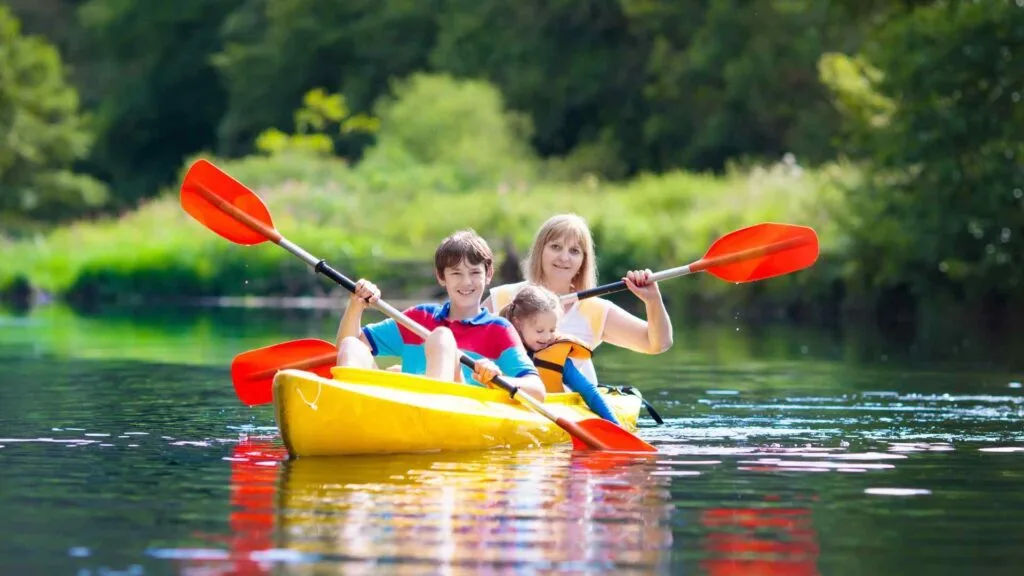
Preparing for Different Weather Conditions
Weather can be unpredictable, especially when camping. Being prepared for various weather scenarios ensures your family’s comfort and safety throughout the trip.
Packing for Various Weather Scenarios
Rainy Day Gear
- Raincoats and Ponchos: Pack waterproof raincoats or ponchos for everyone. Look for options with hoods to keep heads dry.
- Waterproof Shoes or Boots: Ensure everyone has sturdy, waterproof footwear to keep feet dry and prevent slipping.
- Extra Clothes: Pack extra sets of clothes, including socks and underwear, to change into if clothing gets wet.
- Tarp or Canopy: Bring a large tarp or canopy to create a dry communal area for cooking, eating, and playing.
Hot Weather Essentials
- Sunscreen: Apply sunscreen regularly, even on cloudy days. Choose a high SPF and water-resistant formula.
- Hats and Sunglasses: Wide-brimmed hats and UV-protective sunglasses help shield against the sun’s rays.
- Hydration: Bring plenty of water and encourage regular hydration. Pack reusable water bottles for each family member.
- Light Clothing: Pack lightweight, breathable clothing in light colors to stay cool and comfortable.
Cold Weather Preparations
- Layered Clothing: Pack layers, including thermal underwear, sweaters, and jackets, to adjust to changing temperatures.
- Warm Sleeping Gear: Bring sleeping bags rated for low temperatures, along with extra blankets and sleeping pads for insulation.
- Warm Accessories: Include hats, gloves, and scarves to keep extremities warm, especially during early mornings and evenings.
- Hot Drinks: Pack supplies for hot drinks like cocoa or tea to warm up quickly.
Planning Activities for Bad Weather
Indoor Games and Entertainment
- Board Games and Cards: Pack a selection of compact board games and card games for indoor fun.
- Books and Coloring Supplies: Bring books, coloring books, and crayons or markers for quiet, creative activities.
- Portable Electronics: Consider bringing a tablet loaded with movies or games for rainy days, but set limits on screen time to encourage other activities.
Adjusting Outdoor Plans to Stay Safe and Comfortable
- Flexible Itinerary: Have a flexible plan that allows for changes based on the weather. Move outdoor activities to different times or days if necessary.
- Shelter Options: Ensure you have adequate shelter, whether it’s a sturdy tent, a tarp, or access to a nearby shelter. Consider bringing a large tent with a screened porch for more indoor space.
- Rainy Day Exploration: If it’s safe, explore the outdoors in the rain with appropriate gear. Puddle jumping, rain walks, and observing how nature changes in the rain can be fun and educational.
Pro Tips for Weather Preparedness
- Check the Forecast: Monitor the weather forecast for your camping area leading up to and during your trip. Be prepared for sudden changes.
- Pack Smart: Organize gear so that essential items like rain gear, warm layers, and sunscreen are easily accessible.
- Emergency Shelter: Consider packing an emergency shelter or bivy sack in case of severe weather.
- Stay Informed: Know the signs of extreme weather conditions like thunderstorms or heatwaves and have a plan to seek shelter if needed.
By being well-prepared for different weather conditions, you can ensure your family stays comfortable and safe during your camping trip. Teaching kids how to adapt to various weather scenarios will also help them develop resilience and a deeper appreciation for the outdoors.
Tips for a Smooth Camping Experience
A successful camping trip with kids involves more than just packing the right gear and planning fun activities. Here are some tips to ensure a smooth, enjoyable experience for everyone.
Setting Up a Kid-Friendly Campsite
Creating a Comfortable and Safe Sleeping Area
- Tent Setup: Choose a spacious tent with enough room for everyone to sleep comfortably. Consider a tent with separate rooms or dividers for added privacy.
- Sleeping Arrangements: Use sleeping pads or air mattresses for cushioning and insulation. Arrange sleeping bags and blankets to keep everyone warm and cozy.
- Personal Space: Allow kids to have their own sleeping area with their favorite pillow, blanket, or stuffed animal to make them feel secure.
Organizing Gear and Keeping the Campsite Tidy
- Designated Areas: Establish specific areas for cooking, eating, playing, and sleeping to keep the campsite organized.
- Storage Solutions: Use bins, bags, and hangers to keep gear organized and off the ground. Label containers to make it easy to find items.
- Clean-Up Routine: Implement a daily clean-up routine where everyone helps tidy the campsite, wash dishes, and put away gear.
Maintaining Routines and Schedules
Balancing Relaxation and Activity Time
- Activity Schedule: Plan a mix of activities and downtime to keep kids engaged without overwhelming them. Alternate between high-energy activities and restful periods.
- Quiet Time: Designate quiet times for reading, napping, or simply enjoying the sounds of nature. This can help kids recharge and prevent burnout.
Ensuring Kids Get Enough Rest and Nourishment
- Regular Meals: Stick to regular meal times to keep kids’ energy levels stable. Pack plenty of healthy snacks to keep hunger at bay between meals.
- Hydration: Encourage kids to drink water regularly, especially during physical activities and hot weather.
- Bedtime Routine: Maintain a familiar bedtime routine, even while camping. This could include a bedtime story, brushing teeth, and a consistent lights-out time.
Encouraging Kids to Embrace the Camping Experience
Promoting a Positive Attitude Towards Nature
- Nature Exploration: Encourage curiosity and exploration. Teach kids about the plants, animals, and natural features they encounter.
- Respect for Nature: Instill a sense of respect and responsibility for the environment. Explain the importance of not disturbing wildlife and leaving nature as you found it.
Making Camping a Fun and Memorable Adventure
- Campfire Fun: Plan special campfire activities like storytelling, singing songs, or making s’mores to create lasting memories.
- Involve Kids in Planning: Let kids help with planning the trip, choosing activities, and setting up the campsite. This involvement can increase their excitement and sense of ownership.
- Capture the Moments: Bring a camera or smartphone to document the trip. Encourage kids to take their own photos and create a camping scrapbook or journal.
Pro Tips for a Smooth Camping Experience
- Stay Flexible: Be prepared to adapt your plans based on the kids’ interests, energy levels, and weather conditions. Flexibility can make the trip more enjoyable for everyone.
- Emergency Preparedness: Have a plan for dealing with minor mishaps or emergencies. Knowing how to handle unexpected situations calmly can prevent stress and keep the trip on track.
- Comfort Items: Bring a few comfort items from home to help kids feel more secure and comfortable in the new environment.
- Positive Reinforcement: Praise kids for their efforts and accomplishments during the trip. Positive reinforcement can build their confidence and enthusiasm for future camping adventures.
By following these tips, you can create a smooth, enjoyable camping experience that leaves your family with happy memories and a love for the great outdoors. Encouraging kids to embrace the camping adventure will foster their connection with nature and inspire future outdoor explorations.
Conclusion
Camping with kids can be a rewarding and unforgettable experience for the whole family.
By planning carefully, packing thoughtfully, and embracing the adventure, you can create a safe and enjoyable environment where your children can explore, learn, and have fun.
Here’s a quick recap and some final tips to ensure your camping trip is a success.
